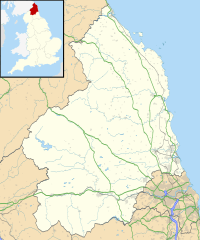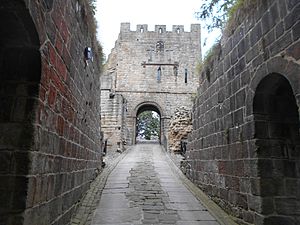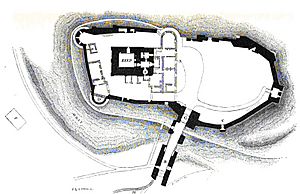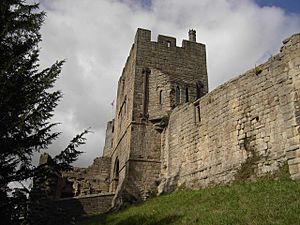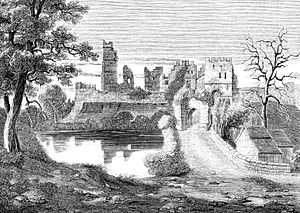Prudhoe Castle facts for kids
Quick facts for kids Prudhoe Castle |
|
|---|---|
| Northumberland, England | |
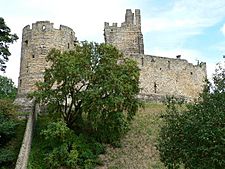
Prudhoe Castle
|
|
| Coordinates | 54°57′50″N 1°51′14″W / 54.964°N 1.854°W |
| Type | Motte-and-bailey converted to keep and bailey |
| Site information | |
| Owner | English Heritage |
| Open to the public |
Yes |
| Site history | |
| Materials | Stone |
Prudhoe Castle is an old English castle that is now a ruin. It stands on the south bank of the River Tyne in Prudhoe, Northumberland, England. This castle is a very important historical site. It is protected as a Scheduled Ancient Monument and is also a Grade I listed building, which means it's a building of special historical interest.
Contents
Who Built Prudhoe Castle?
Archaeologists have found that the very first castle here was built around the mid-11th century. It was a motte and bailey castle, which was a common type of castle built by the Normans. A motte and bailey castle had a tall mound (the motte) with a tower on top, and a fenced-in yard (the bailey) below.
The Umfraville Family Takes Over
After the Normans took over England, the Umfraville family gained control of the Prudhoe area. A man named Robert d’Umfraville was officially given the land by King Henry I. The Umfravilles likely started building on the site even before this.
At first, the castle probably had wooden fences. The Umfravilles, possibly Robert, replaced these with strong walls made of clay and stones. Later, they built a stone outer wall and a gatehouse.
Battles and Changes at Prudhoe Castle
In 1173, William the Lion, the King of Scotland, invaded northern England. He wanted to claim the earldom of Northumberland. Odinel II, who was the head of the Umfraville family at the time, did not support him. Because of this, the Scottish army tried to capture Prudhoe Castle. They failed because they weren't ready for a long fight.
The next year, King William attacked the castle again. But Odinel had made the castle's defenses even stronger. After only three days, the Scottish army gave up and left. After this attack, Odinel made the castle even better. He added a stone keep (the main tower) and a large hall.
Odinel passed away in 1182, and his son Richard took over. Richard later disagreed with King John. Because of this, King John took away Richard's lands, including Prudhoe Castle. Richard got his lands back in 1217, after King John died.
Richard's son, Gilbert, inherited the castle in 1226. Gilbert's son, also named Gilbert, took over in 1245. This Gilbert also became the Earl of Angus in Scotland, which meant he owned a lot of land there. But he still spent time at Prudhoe Castle. It's thought that he made more improvements to the castle.
Gilbert fought in battles for Henry III of England and Edward I of England. He died in 1308, and his son, Robert D’Umfraville IV, became the owner. In 1314, Robert was captured by the Scots at the Battle of Bannockburn. He was soon released, but he lost his Scottish lands. In 1316, King Edward gave Robert money to keep soldiers at Prudhoe Castle.
In 1381, the last Umfraville owner, Gilbert III, died without children. His wife later married Henry Percy, 1st Earl of Northumberland. When she died in 1398, Prudhoe Castle became part of the Percy family's lands.
The Percy Family's Time
The Percy family added a new great hall to the castle soon after they took it over. Henry Percy, 1st Earl of Northumberland fought against King Henry IV. Because of this, the king took away his lands, including Prudhoe Castle, in 1405. The castle was then given to the future Duke of Bedford, who was King Henry IV's son. He kept it until he died in 1435, and then it went back to the Crown.
The Percy family got Prudhoe Castle back in 1440 after a long legal fight. However, Henry Percy, 3rd Earl of Northumberland fought on the losing side in the Wars of the Roses. He was killed in battle in 1461. In 1462, King Edward IV gave Prudhoe to his younger brother, George, Duke of Clarence. But George only owned it for a short time before the king gave it to Lord Montague.
The castle was returned to the fourth Earl in 1470. The Percy family's main home was Alnwick Castle, so Prudhoe was often rented out to other people. However, in 1528, Henry Percy, the 6th Earl, lived at the castle. His brother, Sir Thomas Percy, also lived there later. Both the Earl and Sir Thomas were involved in a protest called the Pilgrimage of Grace in 1536. They were found guilty of treason and executed. After this, the castle was taken by the Crown. In 1537, it was reported that the castle had houses and towers that could be lived in, but they needed some repairs.
The castle was given back to Thomas Percy, the 7th Earl, around 1557. He was found guilty of taking part in another protest called the Rising of the North in 1569. He tried to escape but was caught and executed in 1572.
After this, the castle was rented out to many different people. It stopped being used as a home after the 1660s. By 1776, it was reported to be a ruin.
Between 1808 and 1817, Hugh Percy, 2nd Duke of Northumberland, did a lot of work to repair the old parts of the castle. He replaced the old buildings inside the walls with a Georgian mansion next to the keep.
In 1966, the castle was given to the Crown. Today, English Heritage looks after it, and it is open for people to visit.
What Does Prudhoe Castle Look Like?
The castle sits on a high ridge about 150 feet (46 meters) above the River Tyne. Part of it is surrounded by a deep ditch called a moat. The land to the north drops steeply down to the river.
The main entrance to the castle is on the south side. On one side of the entrance is a mill pond, and on the other side are the remains of an old water mill. You enter the castle through a barbican, which is a fortified gateway built in the early 14th century.
The gatehouse, built in the early 12th century, leads into the outer yard, called the outer ward. This area has the remains of several buildings. On the north side, against the outer wall, are the remains of the Great Hall. This hall was built by the Percies when they took over the castle. Later, in the late 15th century, a new hall was built to replace it.
On the west side of the outer ward is the manor house, built in the early 19th century. This building now has a visitor's shop and rooms with exhibitions. At the south end of the manor house, there's a gateway that leads into the inner yard, called the inner ward.
The most important part of the inner ward is the keep, which is the main tower from the 12th century. The keep's walls are 10 feet (3 meters) thick! Inside, it measures about 20 feet by 24 feet (7.3 meters by 6.1 meters). It used to have two floors and a sloped roof.


